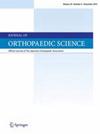使用加速度计检测高胫骨截骨术前和术后一年骨性关节炎膝关节的变位推力。
IF 1.5
4区 医学
Q3 ORTHOPEDICS
引用次数: 0
摘要
背景:本研究的目的是确定高位胫骨截骨术(HTO)对膝关节骨性关节炎(KOA)内侧室患者步态时屈曲推力的影响,并确定影响术前和术后一年推力的因素。方法:对 60 名 KOA 患者(70 个膝关节,其中 56 个膝关节采用开放式楔形截骨术,14 个膝关节采用闭合式楔形截骨术)实施高位胫骨截骨术。对照组由 28 名正常对照组受试者组成。术前和术后一年对几项参数进行了评估。屈曲推力被定义为大腿相对于小腿在冠状面上的加速度。测量并分析了膝关节损伤和关节炎结果评分(KOOS)、膝关节角度、X光片以及自由速度步态时的膝关节内外侧加速度:HTO 一年后,KOOSs、膝关节伸展角度和膝关节活动范围均有所改善(p 结论:HTO 一年后,KOOSs、膝关节伸展角度和膝关节活动范围均有所改善:步行速度与术前、术后和对照组的加速度有明显相关性。术前,KOA 患者大腿相对于小腿的内外侧加速度明显高于正常对照组,而 HTO 术后则没有变化。然而,手术后,在对步行速度进行调整后,其加速度明显降低。本文章由计算机程序翻译,如有差异,请以英文原文为准。
Use of accelerometry to detect varus thrust of osteoarthritic knees before and one year after high tibial osteotomy
Background
The purpose of this study was to determine the effects of high tibial osteotomy (HTO) on varus thrust during gait in patients with medial compartment knee osteoarthritis (KOA), and to identify factors that influence thrust before and one year after surgery.
Methods
HTO was performed in 60 KOA patients (70 knees, including 56 knees by open wedge and 14 by closed wedge). The control group comprised 28 normal, control subjects. Several parameters were evaluated before surgery and one year thereafter. Varus thrust was defined as acceleration of the thigh relative to the lower leg in the coronal plane. Knee-injury-and-osteoarthritis-outcome scores (KOOSs), knee joint angles, radiography, and mediolateral knee acceleration during free speed gait were measured and analyzed.
Results
One-year after HTO, KOOSs, knee extension angles, and range of knee motion were improved (p < 0.001). The hip-knee-ankle angle and joint-line-convergent angle (JLCA) had decreased (p < 0.001), and walking speed had increased (p < 0.001). Preoperatively, patient acceleration was significantly (p < 0.05) higher than that of controls, and it did not change after HTO. However, it was reduced significantly (p < 0.05) after adjusting for walking speed. Walking speed correlated significantly with acceleration preoperatively, postoperatively, and among controls. Surgical methods (open-wedge/closed-wedge HTO) and correction angle did not affect postoperative acceleration. There was a low correlation between acceleration and KOOSs (KOOSa, KOOSp), knee joint angles, or JLCA postoperatively, but no relationship was found between acceleration and these parameters in the preoperative or the control group.
Conclusions
Walking speed correlated significantly with acceleration preoperatively, postoperatively, and with those of controls. Mediolateral acceleration of the thigh relative to the lower leg in patients with KOA was significantly higher than that of normal controls before surgery, and it did not change after HTO. However, after surgery it was reduced significantly after adjusting for walking speed.
求助全文
通过发布文献求助,成功后即可免费获取论文全文。
去求助
来源期刊

Journal of Orthopaedic Science
医学-整形外科
CiteScore
3.00
自引率
0.00%
发文量
290
审稿时长
90 days
期刊介绍:
The Journal of Orthopaedic Science is the official peer-reviewed journal of the Japanese Orthopaedic Association. The journal publishes the latest researches and topical debates in all fields of clinical and experimental orthopaedics, including musculoskeletal medicine, sports medicine, locomotive syndrome, trauma, paediatrics, oncology and biomaterials, as well as basic researches.
 求助内容:
求助内容: 应助结果提醒方式:
应助结果提醒方式:


